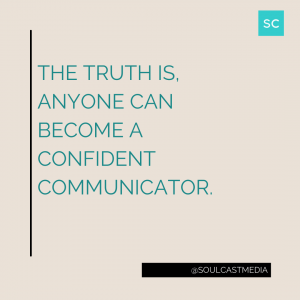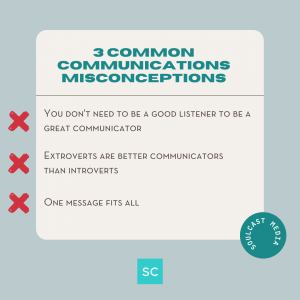3 Common Communications Misconceptions
There are so many communications misconceptions out there. For example, only extroverts can be great communicators. This common misconception can create mental barriers for introverts and extroverts.
The truth is, anyone can become a confident communicator.
Breaking communications misconceptions is critical to career success. When you understand communications, you can lead your team with confidence. According to Pumble, teams who communicate effectively in the workplace may see a 25% increase in productivity. We’ve broken down 3 common communications misconceptions below.
1. Effective Communication Doesn’t Require Good Listening Skills
A common communications misconception is you don’t need to be a good listener. This is simply not true. In fact, listening is critical to effective communication. Your body language, and how you respond and relate to others are all part of active listening.
Consider the following:
- Body Language – Your body language communicates to others without saying a word. When you practice active listening, you can use your body language to communicate with the person speaking. For example, angling your body towards the person speaking, making eye contact, and nodding your head, are ways to show the speaker you are interested in their message.
- Thoughtful Responses – Have you ever asked a question only to realize the person you were speaking to obviously wasn’t listening to you? Did they respond to your question in a way that didn’t make sense? This is exactly why listening is critical to communications. When you practice active listening, you can give a thoughtful response. For example, as the listener, you can paraphrase what the person said to make sure you understood their message. You can say something like, “What I heard you say was XYZ.” Thoughtful responses indicate you were listening.
- Management – As a manager, you must be an active listener. For example, your team will come to you with issues. It is up to you to help them resolve these issues. However, if you aren’t actively listening to them, you may not fully understand the problem. This can cause a lot of miscommunication and loss of productivity. Listening will help you become a better manager.
Although it may seem like you don’t need good listening skills to communicate, this is a myth. Active listening is critical for effective communication.
2. Extroverts Are Better Communicators
While extroverts can be great communicators, they aren’t necessarily better at communicating than introverts. In fact, extroverts need help communicating just like introverts. Both introverts and extroverts can become excellent communicators. This is because communication is a skill you can learn.
Consider the following:
- Analyzing Data – Many introverts naturally can take in a lot of information and analyze it before responding. For example, when given a report, introverts may read the report and sit on it for a day or two before they respond. Their ability to critically analyze data allows them to respond rather than react. When they do respond, their message is thorough and effective. The ability to analyze data helps introverts effectively communicate.

- Allowing Silence – Extroverts often struggle to allow for silence in a conversation. However, introverts are better at allowing silence. Silence gives other people the opportunity to speak. Communication is a two-way street. If you don’t allow others to speak, you can’t hear their point of view. For example, when leading a meeting, before you move on to the next point, take a moment and ask if there are any questions or concerns. Don’t be afraid to sit in the silence for a few moments. This will give everyone in the meeting a chance to speak up.
- Sensing – Sensing what is happening within the workplace is a powerful tool. Introverts are usually able to sense non-verbal cues from their peers. Sensing directly correlates with emotional intelligence, which gives you the ability to respond with empathy and create loyalty. Your colleagues and team may also be much more willing to go the extra mile for you if they feel like you genuinely understand them and connect with them.
Extroverts aren’t automatically better communicators than introverts. Introverts have innate skills to have them be effective communicators.
3. One Message Fits All
Everyone has a preferred method of taking in information. Some people prefer to read, while others prefer to listen. Unfortunately, sending one message isn’t going to work for everyone within your organization. This is why it is essential to know how to communicate through several channels.
Consider the following:
- Video Communications – Video communications are a great way to reach your audience. You can prerecord these messages or go live on a social media platform like LinkedIn. Video communications still require you to maintain your executive presence. For example, you will want to pay attention to what you wear on camera. Try to stick with solid jewel-toned colors. Avoid anything with a busy pattern, as this won’t translate well on video.
- Written Communications – Emails, newsletters, press releases, and blog posts are types of written communications. The challenge with written communications is your audience doesn’t hear the tone with which you are sending the message. Because of this, you will want to make sure you are using clear and concise communications. For example, one way to make sure the intent of your message matches the impact is to read your communication out loud to yourself. Try reading it a few different times. You can pick up on any inconsistencies and rewrite anything that doesn’t match your intent when you do this.

- Verbal Communications – Because some people on your team respond better to verbal communications, you need to be a confident verbal communicator. This means being clear in your messaging. There are several ways you can be a confident verbal communicator. For example, one way to make sure your message is clear is to avoid using filler words. These words are the ums, uhs, ahs that often can creep into your speech. These words can make you come across as unsure and can distract from your message. The more you practice your message, the more confident you will be.
When you can communicate your message through several communications channels, you will reach more people with your message.
There are so many misconceptions when it comes to communications. The good news is, becoming a more effective communicator is possible. No matter where you are on the communication scale, it is never too late to begin communicating at your highest level.
__
Whenever you’re ready, there are 3 ways we can help you:
- Discover your communications style so you know where to start. Over 4,000 people have found theirs here.
- Attend our monthly communication workshop to build communications confidence (new topics: public speaking, advocating for yourself, building credibility, etc) here.
- Get your brand in front of 43k+ people by sponsoring our newsletter or Soulcast Media | LIVE LinkedIn events [contact: hello@soulcastmedia.com]











